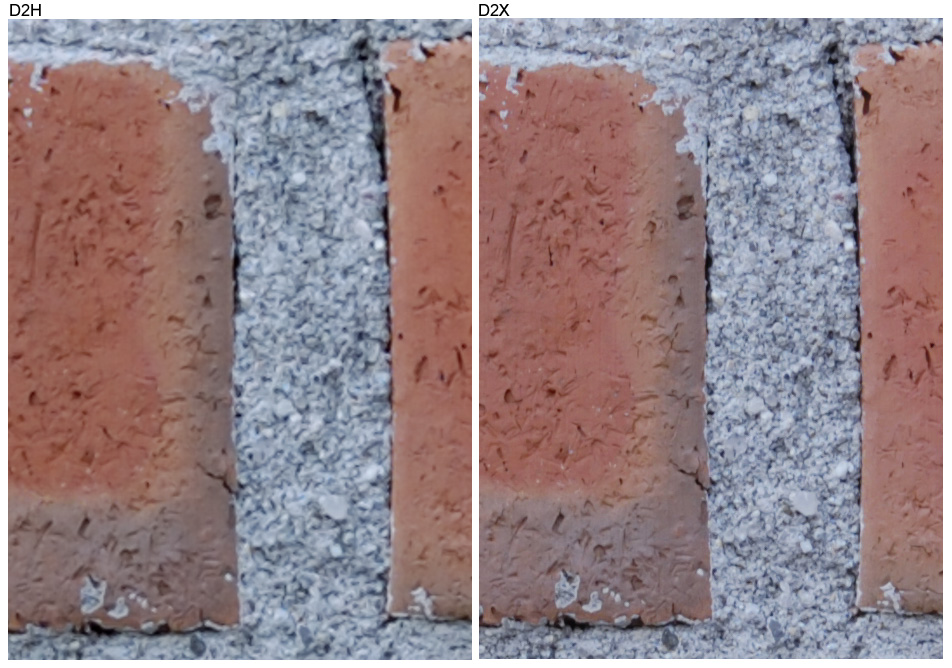| Nikon D2X Digital Camera
Reviewed |
|
|
| by Bjørn
Rørslett |
|
3.
Image Quality
Nikon D2X has,
by a very comfortable margin, the best image quality of any Nikon
DSLR so far available to the public. I wasn't exactly
surprised, given the efforts put into creating this camera. The
clarity of detail makes the image come alive, it simply
"is" a representation of itself and no longer a
facsimile of reality. When you realise all this quality arises
from an imager of physical dimension 15.7 x 23.7 mm, the image
clarity is even more impressive.
Looking at a D2X image is like
removing a veil before your eyes
|
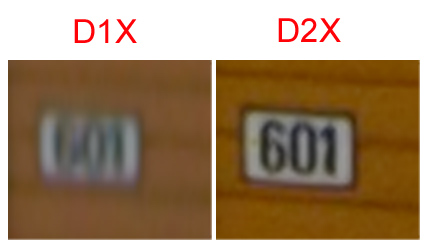
|
| D1X, the old
champion amongst Nikon DSLRs, is absolutely no match in image quality to the new D2X.
These two top models are, by any method of comparison,
simply not in the same league. D2X wins hands down. Shown above are 400% crops (pixel
based, resized in Photoshop using bicubic method) shot at
the same angular pixel view with the 12-24DX, f/8, 12mm
setting, 1/320 sec @ ISO 125 for each camera. The
recorded image sizes are equal within a few per cent. The
crop is from the centre of the frame. Files were shot as
NEF and processed in Nikon Capture 4.2 with no sharpening
or other adjustments. D1X NEF opened as 10 MPix in
Capture.
|
To exploit fully the potential of D2X
imagery, using raw (NEF) files is the optimal approach. However,
as only Nikon Capture 4.2 at this time of writing supports D2X
NEFs, we don't know yet if other (third-party) software* might
improve the image quality even further. Nikon Capture 4.2 itself
has a user interface marred by a slightly vulgar
"XPish" quality, and it isn't a superfast performer in
any way. Also, the latest version of this program is a memory hog
if there ever was one, needing at least 1 GB of memory on
the PC to run smoothly. Converting a NEF from D2X is best done on
a dual-CPU machine with 2 GB RAM or more. Don't ever feel tempted
to zoom into a NEF image on a machine having less than 1 GB of
memory, or you are likely to get a system hang or crash. Batch
processing features are poor and rudimentary compared to those of
my preferred Bibble Pro software. However, image output quality
is superb both from D1-series as well as D2-series NEFs, so I
won't complain more than I've already done. And Bibble will
support D2X shoretly, I have tried it in
* BibblePro already
supports D2X in a beta version and official support is to
appear in the near future
Setting up valid comparison tests shots for
film is quite straightforward, because recorded image
magnification and the order of secondary magnification after
processing and enlargement are identical, provided the setup
incorporates a stationary subject and a camera position which is
fixed at a given distance to the subject itself. My test subject
typically is the brick wall outside my office premises, and this
part of the world is little troubled with earthquakes so the
stationarity criteria should be fulfilled.
With digital cameras, things act a little
differently. Thus, you can easily get a setup giving identical
magnification of the image projected onto the CCD/CMOS/LBCAST
chip inside the camera. However, because chip size may differ so
might angle of view for the end image, or chip pixel counts may
differ to result in non-identical angular resolution of the
pixels. A sound and basic principle underlying scientific tests
is that you should be able to have full control of the variables
involved and preferably change only a single variable
independently of the others.
For tests with D2X set against D1X and D2H,
I ran a whole gamut of procedures to ensure valid comparisons
between the contenders. When image input magnification was kept
constant, the increased clarity of D2X versus D1X images was
simply stunning. In direct comparisons to D2H, when the angular
view of pixels were equalised, D2X still showed the superior
quality.
To compare pixel quality directly, I ran a
separate setup in which the subject-camera distance was changed
to give the pixels equal angular view. This approach is valid
given that the performance of the test lens is constant across
the distance range involved, which I'm very certain applies to my
AFS 200 VR lens between 3 and 5 m. Since this lens has a focal
length which gradually shortens as the lens is focused closer,
and the alteration of focal length itself is undocumented from
Nikon, it is frustratingly difficult to get a perfect match in
pixel angular coverage, but I got within a few percent of the
target anyway so that'll do for this time.
| Nikon D2H vs D2X, or LBCAST vs
CMOS imager |
|
Test images of my
"favourite" subject, a brick wall. Shot with
AFS 200/2 VR Nikkor at f/5.6, 1/80 sec, D2X and D2H at
200 ISO equivalency. Both crops shown at 200%
magnification, NEF files processed in Nikon Capture 4.2
with no sharpening or other adjustments applied to them.
It is readily
apparent that both cameras deliver images with well
defined crisp detail and nicely rendered colours, but D2X
is just better than D2H. And you should not forget to
factor in its 3 times bigger file size, either.
Images © Bjørn Rørslett/NN
|
So, tests very distinctly show D2X is
capable of the better image rendition of the current Nikon DSLRs.
However, a question remains unanswered, that is, how can these
images stand up to magification. We all know by now that good
digital images can be printed to sizes larger than the pixel
numbers alone would indicate, by virtue of the
"cleanliness" of the digitally recorded image. The
example below gives pointers to the scalability of D2X images.
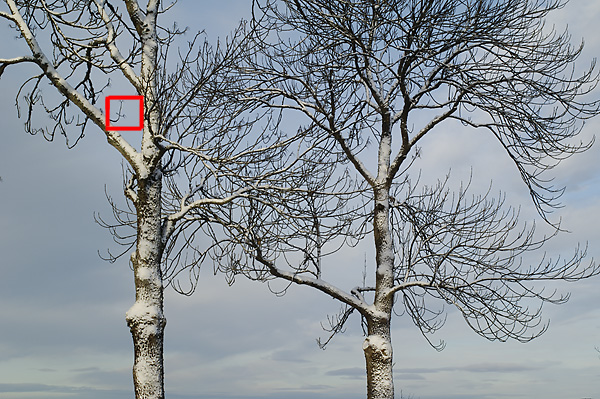
© Bjørn
Rørslett/NN
|
|
| Image
sharpness not only depends on the lens, aperture, and the
digital camera (or film, in case of film-based systems),
but inseparably on subject contrast. This shot, captured
with the 45 mm f/2.8 P Nikkor @f/11, 1/100 sec, 100 ISO
setting on D2X, has plenty of contrast and image detail.
Even for a hand-held shot the clarity is impressive. Total magnification is 15.8X linear
from the imager size. Neither this nor any of the crops
below has been sharpened in any way, they are just jpgs
straight from the original NEF.
|
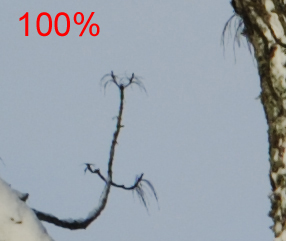
|
| This crop
(shown at 100%, actual pixel size) corresponds to a print
of 24 x 36cm @300 dpi (9.5 x 14.3 "). Image detail
is smaller than can be comfortably viewed at this print
size, so the full potential of the camera hasn't yet been
realised. |
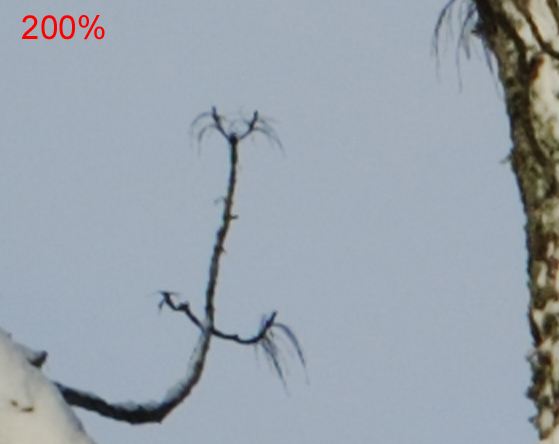
|
Here, the crop is 200% (from pixel
size), corresponding to a print size of 48.2 x 72.6 cm
@300 dpi (19 x 28.5 "). Total print magnification is
31.5X linear.
The image
coherence is high, detail is smooth although some
softening inevitably occurs, and grain is simply not
visible.
|
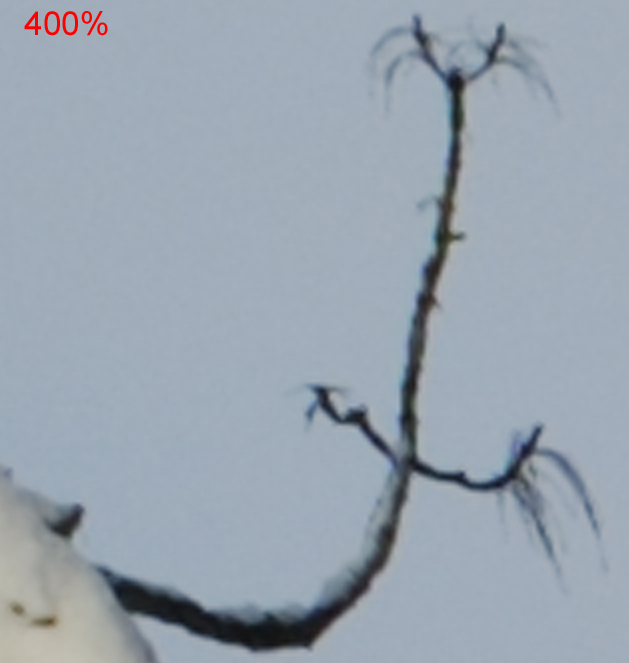
|
| Finally, here is a
400% (pixel based) crop, now representing a huge print of
96.4 x 145,2 cm @ 300 dpi (38 x 57 "). Image detail
is pretty well kept despite the great enlargement and the
lack of graininess in the sky is noteworthy. And
obviously, given the perceived image sharpness, my hands
are less shaky than I previously thought. Total print magnification is a tremendous
61.4X, way beyond what any 35 mm film can deliver with
similar clarity and lack of graininess.
(the 45/2.8 P Nikkor, being a
simple 4/3 Tessar design, has some residual colour
fringing which comes into view at extreme magnification,
but this should be of little concern)
|
My conclusion is that you will get image
quality from D2X to satisfy even the most critical needs, for any
application to which 35 mm systems can be used.
The issues of image noise and imperfections
are covered in the next section, so read on to learm more.

